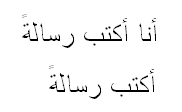Basic Arabic Course - Lesson 2:
Arabic Grammar
This lesson is all about Arabic grammar. Don't be scared though - I'll explain everything in easy steps. Upon completion of the lesson you will be able to form simple Arabic sentences. First, let me give you a quick outline of the grammatical aspects of Arabic discussed here:
- The verb "to be" is not necessary to form a simple sentence.
- Arabic has two grammatical genders.
- Arabic words are formed according to a root system.
- Arabic verbs change according to the subject.
Let's go through these points in more detail.
The verb "to be" is not necessary to form a simple sentence.
In English, the verb "to be" is used to form simple sentences such as "The house is big". In Arabic, the verb "to be" is usually dropped when describing something in the present tense. So, our example sentence would become "The house big."
Let me show you some examples. Remember to start reading from the right:
| كبير | البيت |
kabeer |
al-bayt |
big |
the-house |
The house is big. |
|
| ممتاز | الأكل |
mumtaaz |
al-akl |
excellent |
the-food |
The food is excellent. |
|
| صغيرة | البنت |
Sagheera |
al-bint |
small |
the-girl |
The girl is small (young). |
|
Note that when describing past occurences, the verb "to be" is necessary:
| كبيرا | البيت | كان |
kabeeran |
al-bayt |
kaana |
big |
the-house |
was |
The house was big. |
||
The word "kaana" is the past tense of the verb "to be".
Arabic has two grammatical genders.
In Arabic a word can be either masculine or feminine - just like in French. Feminine words are usually easy to spot, because most of them end in ـة ة (taa' marbooTa). Below are some examples:
| Word | Feminine Singular | Masculine Singular |
| student | طالبة Taaliba |
طالب Taalib |
| friend | صديقة Sadeeqa |
صديق Sadeeq |
| moslem | مسلمة muslima |
مسلم muslim |
| ambassador | سفيرة safeera |
سفير safeer |
| dog | كلبة kalba |
كلب kalb |
Arabic words are formed according to a root system.
Most Arabic words derive from a three or four letter root. This can best be explained using a concrete example.
The following words all derive from the same three root letters - كتب (k t b):
| to write | كتب kataba |
| writer | كاتب kaatib |
| written | مكتوب maktoob |
| book | كتاب kitaab |
| writing | كتابة kitaaba |
| office | مكتب maktab |
| bookstore / library | مكتبة maktaba |
| dictation | استكتاب istiktaab |
Once you've figured out how this system works, you will be able to construct a lot of words from the same root, saving you valuable time in memorizing voaculary. For now, simply try to recognize similarities between words and see if you can spot the three (or four) root letters.
Arabic verbs change according to the subject.
Another similarity Arabic has to French is that verbs change according to their subject. In English, verbal conjugations have been grately simplified over the last few centuries. All that remains now is the "s" added to verbs for "he", "she", "it". E.g. "I run", but "he runs". So, let's take a look at the verb "to write":
You will notice that Arabic has more personal pronouns than English. Specifically, Arabic has something called a "dual" that only applies to two persons. There is also a feminine and a masculine "they".
| I write | أكتب aktub(u) |
أنا ana |
| you (sgl.) write (masculine) | تكتب taktub(u) |
أنت anta |
| you (sgl.) write (feminine) | تكتبين taktubeen(a) |
أنت anti |
| he writes | يكتب yaktub(u) |
هو huwa |
| she writes | تكتب taktub(u) |
هي hiya |
| you two write | تكتبان taktubaan(i) |
أنتما antuma |
| we write | نكتب naktub(u) |
نحن naHnu |
| you (pl.) write (masculine) | تكتبون taktuboon(a) |
أنتم antum |
| you (pl.) write (feminine) | تكتبن taktubna |
أنتنّ antunna |
| they write (masculine) | يكتبون yaktuboon(a) |
هم hum |
| they write (feminine) | يكتبن yaktubna |
هنّ hunna |
1. Note that in Arabic it is not necessary to use the personal pronouns in front of the verbs. This is because the conjugated verb itself makes it clear who its subject is.
In the example below both sentences mean "I write a letter".

ana aktub(u) risaalatan
aktub(u) risaalatan
"letter" is risaala (رسالة).
2. Note that some endings (e.g. the "a" at the end of taktuboon(a) ) are usually omitted in normal speech.
End of Lesson 2: Arabic Grammar
In the next lesson I'll introduce you to some essential vocabulary.